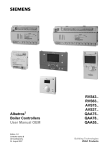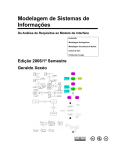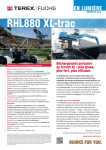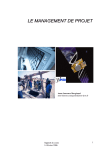Download the development of an augmented reality
Transcript
THE DEVELOPMENT OF AN AUGMENTED REALITY-BASED DATA VISUALIZATION SYSTEM FOR COMMISSIONING OF AIR HANDLING UNITS Sanghoon Lee, PhD student, School of Architecture, Carnegie Mellon University; [email protected] Muhsine Tanyel Türkaslan-Bülbül, PhD, Department of Architecture, Istanbul Technical University; [email protected] Ömer Akin, PhD, Professor, School of Architecture, Carnegie Mellon University; [email protected] ABSTRACT: This paper discusses the development of an Augmented Reality-based data visualization system that supports commissioning HVAC systems during construction, occupancy, and operations phases. Commissioning is a process that generates a significant amount of data. Therefore a Building Commissioning data model has been developed to effectively manage such data and facilitate the computational support for commissioning work. One of the challenges of this model-based approach has been to reduce the inefficiency caused by the disparate and multiple attributes of the Building Commissioning data. In order to meet this challenge, we aim to develop an Augmented Reality-based data visualization interface which can automatically detects a piece of equipment and visualizes all necessary data relevant to the particular equipment for the commissioning procedures. This paper focuses on the functional requirements and system architecture needed to design such an interface. KEYWORDS: Augmented Reality, Data Visualization, Building Commissioning Data Model, Air Handling Unit, and Functional Requirements 1 INTRODUCTION There are numerous and diverse systems within a building. A Building Commissioning Authority (BCxA) needs to ensure that those systems run as intended. A significant amount of data is produced, used and updated throughout Building Commissioning (BCx) phases until the building is delivered to the owner. A computerized system that provides the BCxA with easy access to the BCx data and documents stored throughout different commissioning phases can make commissioning more efficient. Such a system is intended to locate the necessary data and significantly reduce the time needed to complete the BCx tasks. The core BCx activities are initial inspection to verify that equipment is properly installed and functional performance testing (FPT) to determine that equipment is functioning as intended. There are several software packages that support FPT, such as PACRAT1 (Performance And Continuous Re-Commissioning Analysis Tool) developed by Facility dynamics, WBD2 (Whole-Building Diagnostician) by Pacific Northwest National Laboratory, and ENFORMA3 by Architectural Energy Co. In addition, several private companies provide software solutions along with hardware devices so that the BCxA can monitor equipment performance. For the former BCx activities, BCxA commonly uses visual inspection. In this case, Augmented Reality (AR) technology’s automatic object detection and superimposition of computer-generated data onto a video stream can help the BCxA reduce extra time used for locating equipment-specific data and documents as well as facilitate commissioning without sacrificing reliability. 1 http://www.facilitydynamics.com/pacrat.html 2 http://www.buildingsystemsprogram.pnl.gov/fdd/wbd/index.stm 3 http://www.archenergy.com/products/enforma// 7th International Conference on Construction Applications of Virtual Reality: October 22-23, 2007 155 Several research groups have developed AR-based applications to support various types of activities in the AEC/FM (Architecture, Engineering, and Construction / Facilities Management) domain. Goose et al. (2004) have developed an AR interface called PARIS (PDA-based Augmented Reality Integrating Speech) that aims to support monitoring performance of HVAC systems by allowing the user to see a geometric model of the HVAC components and sensor-derived data. PARIS also allows the user to interact with the system by voice. Kamat and his research team are interested in the development of AR-based systems for construction. To resolve difficulties in using AR devices in outdoor environments, they have developed an AR system using GPS (Global Positioning System) and a 3-DOF (Degree Of Freedom) angular tracking device. The system renders 3D CAD models onto the scenes captured through a camera with the information of user’s position and direction of the user’s view (Behzadan and Kamat, 2007; Behzadan and Kamat, 2006). Dunston et al. (2002) have developed AR CAD (Augmented Reality ComputerAided Drawing), which improves user design comprehension and detects design defects such as interference among three-dimensional components of piping systems. 2 BUILDING COMMISSIONING PROCESS According to the ASHRAE guideline 0-2005, the Building Commissioning Process consists of four phases: 1) PreDesign phase, 2) Design phase, 3) Construction phase, and 4) Occupancy and Operations phase. Türkaslan-Bülbül (2006) has also classified commissioning phases as follows: 1) Program phase, 2) Design phase, 3) Construction phase, 4) Acceptance phase, and 5) Post-Acceptance phase. During the Pre-Design phase, which is comparable to the program phase in Türkaslan-Bülbül’s classification, the main activities are information collection and development of the owner’s project requirements and initial commissioning plan, including commissioning scope and budget. The information collected is crucial for successful building commissioning because it will be used as the primary metric when the building is commissioned from various perspectives. The Design phase includes 1) the development of several documents, such as the Basis of Design, which will be used to manifest the Owner’s Project Requirements in detailed Construction Documents; 2) the development of a Training Plan; and 3) the development of Construction Documents. The Commissioning Plan may be revised accordingly during this phase. Once the Commissioning Plan and Construction Documents are reviewed and accepted by the BCxA, the building is ready to be constructed. In the Construction phase, the building is constructed as designed, and its sub-systems, such as HVAC systems, are installed. The Commissioning Plan is then updated accordingly. Submittals such as shop drawings, equipment submittals, testing procedures and forms are verified, and test procedures are developed. Installation of equipment is observed, equipment is tested according to the testing plan, and results are all documented. In this phase, the BCxA verifies Training Plans. When construction is completed, BCxA carries out most commissioning field activities such as verification of accomplishment of the owner’s project requirements and performance tests. Where ASHRAE guideline 0-2005 describes these activities as the Construction Phase, Türkaslan-Bülbül makes a new phase in her classification called the Acceptance Phase. The Commissioning Plan and Contract Documents are used for the verification and performance tests. When all the systems meet functional requirements documented and the results documents are acceptable to the owner, as-built drawings, operations and maintenance manuals, training documents and final commissioning reports are generated and delivered to the owner. Periodic or continuous commissioning of a building in the Occupancy and Operations phase, called the PostAcceptance phase in Türkaslan-Bülbül’s classification, aims to ensure that the systems in the building continue to provide the building occupants with intended functions. Basically, documents generated during the initial commissioning in the Construction phase are used for proper operations and maintenance for the lifecycle of the building. The documents are then updated with new commissioning results. 3 BUILDING COMMISSIONING DATA MODEL FOR COMMISSIONING AIR HANDLING UNITS (AHU) Various types of information are generated and documented throughout the Building Commissioning process. Further, those BCx data are frequently updated as the commissioning process progresses. Naturally, computerized 7th International Conference on Construction Applications of Virtual Reality: October 22-23, 2007 156 systems can help a BCxA manage BCx-related documents and data so commissioning work can be more effective and efficient without sacrificing reliability. A BCx data model has been developed for this purpose (TürkaslanBülbül, 2006). In addition to the diversity of BCx data types, different BCxA commonly use different terms that actually have the same meaning. Consequently, while reviewing literature and commissioning reports, new terms and attributes were cross-referenced and added as necessary. For those reasons, Türkaslan-Bülbül’s took several steps to make the BCx data model more complete: • Collect as many sources as possible • Compile the obtained sources into Comparative Analysis Tables (CAT) (Akin et al, 2004) • Extend the data set when new sources are obtained by repeating the previous step The latest version of the BCx data model supports commissioning of complete AHUs, whose components include air filter, fan, coil, humidifier, damper, sensor, duct, pump and VAV (Variable Air Volume) box. As shown in Figure 1, the BCx data model supports three commissioning activities that occur in different commissioning phases. The three activities are Specification, System context inspection, and Functional inspection. Specification is the activities of checking performance criteria of equipment. This activity occurs before the Acceptance phase once Specification documents are generated. While System context inspection is the commissioning activity for qualitative inspection of equipment installation status, Functional inspection is the activity to quantitatively measure the performance of equipment. Those two activities are carried out during the Acceptance phase. component 1 System context inspection Equipment 0..* 1 Specification 0..* 1 Functional inspection 0..* 1 Event 0..* Equipment type EquipmentEnum Inspection PerformanceDescription 0..1 SystemContextInspection FunctionalInspection * Inspection values Figure 1 The BC data model core (Türkaslan-Bülbül, 2006) The overall structure of the BCx data model adapts the hierarchical structure of Object-Oriented representation (Figure 2). The core structure of the BC data model was developed first with common attributes that all types of equipment need to have. Then, classes for the components of AHUs are added under each type of building commissioning. The component classes have attributes obtained through CAT. Figures 3 and 4 show the BC data model for coil commissioning. 7th International Conference on Construction Applications of Virtual Reality: October 22-23, 2007 157 Event PerformanceDescription Equip_1 … Inspection Equip_N FunctionalInspection Equip_1 … SystemContextInspection Equip_N Equip_1 … Equip_N Figure 2 Hierarchical structure of the BC data model (Türkaslan-Bülbül, 2006) CoilPerformance +air_f low: Double +entering_air_temp_dry: Double +leaving_air_temp_dry: Double +coil_temp_stratif ication: Integer +coil_status: Integer HeatingCoilPerformance CoolingCoilPerformance +entering_air_temp_wet: Double +leaving_air_temp_wet: Double +coil_f ace_area: Double +coil_capacity: Double +entering_air_relative_humidity: Double +leaving_air_relative_humidity: Double +f ace_velocity: Double HotWaterCoilPerformance +entering_water_temp: Double +leaving_water_temp: Double +water_f low_rate: Double +water_pressure_drop: Double +coil_capacity: Double +air_pressure_drop: Double SteamCoilPerformance +inlet_duct_size: Double +outlet_duct_size: Double +steam_temp: Double +entering_steam_pressure: Double +steam_conn_size: Double +steam_f low_rate: Double +condensate_size: Double +condensate_temp: Double ChilledWaterCoilPerformance +entering_water_temp: Double +leaving_water_temp: Double +water_f low_rate: Double +water_pressure_drop: Double +air_pressure_drop: Double DXCoilPerformance +voltage_phase_A: Double +voltage_phase_B: Double +voltage_phase_C: Double +current_phase_A: Double +current_phase_B: Double +current_phase_C: Double Figure 3 BC data model for coil functional inspection (Türkaslan-Bülbül, 2006) CoilContext +is_f ins_bent: Integer +is_f in_spacing_as_specified: Integer +is_number_of _rows_as_specif ied: Integer +is_room_lef t_f or_coil_replacement: Integer +is_unit_supported: Integer HeatingCoilContext CoolingCoilContext +is_inlet_ductwork_attached: Integer +is_outlet_ductwork_attached: Integer +is_balancing_valve_set: Integer +is_strainer_installed: Integer +is_vents_installed: Integer +is_vents_piped_to_drain: Integer +is_drains_installed: Integer +is_drains_piped_to_drain: Integer ChilledWaterCoilContext HotWaterCoilContext +is_glycol_level_met: Integer SteamCoilContext +is_condensate_piping_attached: Integer +is_steam_piping_attached: Integer DXCoilContext +is_inlet_ductwork_attached: Integer +is_outlet_ductwork_attached: Integer +is_vents_installed: Integer +is_vents_piped_to_drain: Integer +is_drain_installed: Integer +is_drain_piped_to_drain: Integer +is_drain_pans_pitched: Integer +is_drain_pans_piped: Integer +is_condensate_drain_piped: Integer +is_balancing_valve_set: Integer +is_strainer_installed: Integer Figure 4 BC data model for coil context inspection (Türkaslan-Bülbül, 2006) 7th International Conference on Construction Applications of Virtual Reality: October 22-23, 2007 158 4 AUGMENTED REALITY-BASED INTERFACE One of the challenges in this modelling approach has been to reduce the inefficiency caused by the unused attributes included in the BCx data model, which are generally useful but potentially irrelevant to the particular commissioning purpose or scope under consideration. The unused attributes of BCx classes and the rest of the BCx model not only remain dormant but also may end up overwhelming the user. One approach to meet this challenge is to develop an Augmented Reality-based data visualization interface which can automatically detect target equipment and visualize only the necessary data relevant to the particular equipment for that commissioning phase. This section focuses on the functional requirements, representative use-cases and system architecture needed to design such an interface. 4.1 Functional requirements An AR-based interface aims to visualize BC data and documents for effective and efficient building commissioning. Table 1 shows core BCx activities that occur for inspection and performance test purposes during the construction phase. These activities are from Türkaslan-Bülbül’s (2006) BCx data model. Table 1 BC activities during construction and acceptance phases Actor Description of BC activity Construction manager Designer Owner, Commissioning authority Construction manager Designer Owner, Commissioning authority Construction manager Constructs, installs, and start-ups systems Inspects the constructed system Observe system installation and startup, and document progress & deficiency if there is any Certifies that system is complete and operational Inspects the certified system Observe system installation and startup, and document progress & deficiency if there is any Tests, Adjusts, and Balance (TAB) the certified system Owner, Commissioning authority Observe testing, adjusting, and balancing the system and document progress & deficiency if there is any Designer, Commissioning authority Commissioning authority Approves tested, adjusted, and balanced system CxA Verifies HVAC system checks, TAB reports, and Automatic Control Systems Tests functional performance of the system of which HVAC system checks, TAB report, and Automatic Control Systems are verified Necessary data • Submittals: shop drawings, equipment submittals, TAB procedures/forms, test procedures, report forms, data sheets, checklists • Submittals: shop drawings, equipment submittals, TAB procedures/forms, test procedures, report forms, data sheets, checklists • Submittals: shop drawings, equipment submittals, TAB procedures/forms, test procedures, report forms, data sheets, checklists • • TAB report Commissioning plan • Submittals: shop drawings, equipment submittals, TAB procedures/forms, test procedures, report forms, data sheets, checklists Contract documents Commissioning specification • • As shown in Table 1, commissioning activities include the verification of whether systems and assembly are properly constructed, installed, and assembled and also whether the system meets the owner’s requirements for 7th International Conference on Construction Applications of Virtual Reality: October 22-23, 2007 159 performance. For the verification purpose, the roles of the BCxA during the Construction phase include observation and checking the progress of system installation. The following list of functional requirements can help the BCxA effectively verify the target systems. Functional requirement 1: The interface shall visualize geometric models of the HVAC system in a way that the user can intuitively inspect the condition of equipment installation One of the essential tasks for equipment context inspection is to compare the installed system with shop drawings in order to verify that the system is installed as designed. In the BCx data model, significant portions of context inspection attributes are in the following forms: • Is_equipment_name_installed/attached/wired/piped/connected? • Is_equipment_name_installed/sealed/attached_properly? • Is_equipment_name_installed_in_correct_direction? • Is_equipment_name_installed_as_specified? • Is_equipment_name_located_where_required? • Is_size_of_equipment_name_correct? To verify those attributes, the BCxA compares the installed/attached/wired/piped/connected equipment with the shop drawings and equipment specifications. Therefore, the AR interface shall visualize 3D geometric models in a way that the BCxA can intuitively carry out the inspection activities listed above with reliability and accuracy. Functional requirement 2: The interface shall select and visualize necessary attributes of the identified equipment in accordance with the specific BCx phase and the defined BCx scope The number of attributes of classes only increases because new attributes are added to the BCx data model when new sources are compared with it. Consequently, when the BCxA commissions the particular equipment, they often use only a subset of the entire attribute list of classes in accordance with the commissioning scope and phase. For example, in case of commissioning a research building which houses materials that are sensitive to temperature and indoor air quality, attributes that are used should be more detailed and specific than those for a regular office building. In this case, the attributes in the BCx data model will be augmented from both sources. However, the BCxA does not need all the attributes that are specialized for the research building commissioning. Therefore, for effective and efficient commissioning, a proper filtering function shall be necessary. Functional requirement 3: The interface shall be able to access Building Automation Systems (BAS) to retrieve equipment performance related data To carry out FPT, the BCxA needs to read sensor-derived data retrieved from the BAS so that the BCxA can determine whether the target system functions as specified. Although some data can be read directly from the sensor at the site, majority of the necessary data are frequently inaccessible because some sensors are simply hidden inside the system and also because certain types of the sensed raw data need to be manifested. Therefore, the interface shall be able to communicate with BAS so that the BCxA can access sensor-derived performance data of the target equipment. Functional requirement 4: The interface shall automatically identify equipment and location of the user Conventional methods of identifying the target equipment mostly rely on the user’s manual input or navigation of equipment structure. Those methods are frequently inconvenient at the site in which most commissioning activities occur during the construction phase. Furthermore, BCxA could easily be lost while navigating equipment structure because the structure of the system is new to the BCxA. Automatic identification of the target equipment can easily facilitate the identification of equipment as well as location of the user. Currently, several technologies are already available. Examples include RFID (Radio Frequency Identification), Bar code, GPS (Global Positioning System), and computer vision-based AR technology. Therefore, the interface shall have an object-recognition function so that the user can efficiently conduct commissioning work. Figure 5 shows an IDEF0 (Integration DEFinition language 0) diagram that shows the primary functions developed under the consideration of the development of the AR-based interface. 7th International Conference on Construction Applications of Virtual Reality: October 22-23, 2007 160 Video stream Condition Commissioning scope User’s input Identify target equipment Equipment ID Commissioning Phase input Computer vision-based object detection algorithm Commissioning data Geometric model BAS data Function Output Mechanism Retrieve data Equipment-specific data Visualize data Video stream on which Cx data are superimposed Mechanism that superimposes the retrieved equipment-specific Cx data onto the video stream Figure 5 IDEF0 diagram To identify equipment, the AR-based interface takes two inputs: the user’s direct input and video stream. The interface analyzes each picture frame in real time. If the pre-mapped markers are detected, the interface identifies the equipment by looking up the mapping matrix. This function produces the unique ID of the equipment as an output. A computer vision based object recognition algorithm is used. With the equipment ID, the interface accesses various commissioning databases to retrieve data associated with the detected equipment. While retrieving BCx data, the interface takes the BCx phase and scope as control variables resulting in collection of data optimized to the particular BCx phase. For functional inspection of equipment, the AR interface accesses the Building Automation Systems (BAS) by which the target equipment is controlled and monitored. To retrieve sensor-derived data, the interface continuously communicates with the BAS. The retrieved data are then processed and visualized by proper modules. Geometric models are rebuilt and superimposed in 3D AR space by the OpenGL-based rendering engine so that the BCxA can intuitively inspect context of the equipment. Further, the geometric model can be visualized in accordance with the installation schedule by adapting the concept of 4D-CAD, which may allow the BCxA to do their commissioning work easier. The text data, on the other hand, are visualized in 2D AR space so that the user can have better readability. The sensor-derived data obtained from the BAS are displayed in a graphical format as well as in a text format so that the user can see historical trends of equipment performance. 4.2 Representative use-cases Tables 2 and 3 show two representative use-cases which describe context inspection and functional inspection, respectively. Context inspection focuses more on the use of computer-generated geometric models and equipment specifications, whereas functional inspection requires equipment specifications and data from BAS. 7th International Conference on Construction Applications of Virtual Reality: October 22-23, 2007 161 Table 2 A use case for commissioning context of equipment Title: context inspection Primary actors Commissioning agent Secondary actors The owner, Architects, Engineers, Contractors, Facilities Management Service Personnel This use case enables the user to inspect contexts of equipment using the AR interface, which augments geometric models onto the equipment for intuitive comparison. The system also displays equipment specifications so that the BCxA can inspect to see if the installed equipment meets all the owner’s requirements related to the particular equipment. Description 1. 2. 3. Work flow Pre-conditions Post-conditions The user selects “Context Inspection” The user points the camera installed to the system to the target equipment The system detects the equipment by recognizing the visual marker associated with the equipment 4. The system displays a list of equipment components 5. The user selects the target component 6. The system generates a template for commissioning the context of the target component 7. The system superimposes geometric models onto the installed equipment 8. The user carries out context inspection. If necessary, the user can compares the target equipment with its geometric virtual model 9. The user documents commissioning results 10. The user clicks “Save New Document” 11. The system saves the new document 1. 2. 1. 2. The system runs and waits for the user’s command Commissioning documents such as Specifications and Contract Documents are stored in the system The system stores the new document in its database The system prompts the user to enter next command Table 3 A use case for commissioning equipment performance inspection Title: Performance inspection Primary actors Commissioning agent Secondary actors The owner, Architects, Engineers, Contractors, Facilities Management Service Personnel Description This use case enables the user to inspect equipment performance using the AR interface, which displays equipment specifications and performance data retrieved from BAS. 1. 2. 3. Work flow The user selects “Performance Inspection” The user points the camera installed to the system to the target equipment The system detects the equipment by recognizing the visual marker associated with the target equipment 4. The system displays a list of equipment components 5. The user selects the target component 6. The system generates a template for commissioning “Performance inspection” 7. The system superimposes geometric models onto the identified equipment 8. The system accesses the Building Automation System (BAS) that monitors and controls the target equipment and retrieves performance data of the target coil from the BAS 9. The user carries out performance inspection using data retrieved from BAS 10. The user documents commissioning results 11. The user clicks “Save New Document” 12. The system saves the new document Pre-conditions 1. 2. Building Automation Systems are accessible through TCP/IP The system runs and waits for the user’s command Post-conditions 1. 2. The new document is stored in the system The system waits for the user’s next command 7th International Conference on Construction Applications of Virtual Reality: October 22-23, 2007 162 4.3 System architecture of the AR interface Figure 6 shows system architecture of the AR interface, which consists of five managers: an object detection manager, a data fusion and display manager, and three BCx data managers. The object detection manager identifies pieces of equipment by analyzing video stream as well as taking the user’s input. The data fusion and display manager fuses and renders BCx data retrieved from BCx databases by corresponding managers. This BCx data manager takes EXPRESS files to exchange BCx data between the interface and the BCx databases. The geometric model manager parses VRML files and ASE files and renders 3D geometric models. The BAS data manager interacts with BACnet-compatible BAS to retrieve sensor-derived data. The screenshot (on the right side of Figure 6) shows an example of the AR-based interface prototype that is being developed. Data type 1 Last update: XX/YY AR-based Cx data visualization interface Input device Output device BC data manager Object detection manager Data fusion & display manager Geometric model manager Data type 4 Real-time data stream BC data model Data type 2 Last update: XXÕ /YYÕ Geometric model BAS data manager Data type 3 Last update: XXÕÕ /YYÕÕ Geometric model Last update: XXÕÕÕ /YYÕÕÕ BAS Menubar Figure 6 System architecture of the AR interface and interface example 5 CONCLUSIONS This paper presents the development of an AR-based data visualization interface for commissioning of HVAC systems using the BCx data model developed by Turkaslan-Bulbul (2006). Functional requirements to effectively support efficient commissioning activities are discussed. High-level system architecture that fulfils the elicited functional requirements is designed for future implementation. An AR-based data visualization interface can improve context inspection as well as functional inspection. By visualizing three dimensional geometric models onto the site where the equipment is (being) installed, the BCxA can intuitively conduct context inspections without sacrificing reliability. For functional inspection, the AR-based interface can access BAS in order to retrieve sensor-derived data and visualize the corresponding sensor right-onlocation so that the BCxA can see all necessary sensed data. The interface can visualize the retrieved data in 2D format as well as in 3D AR space. 6 FUTURE WORK The current version of the BCx data model represents Air Handling Units only. Naturally, collection of attributes used for commissioning other types of HVAC systems is necessary in order to computationally support commissioning of complete HVAC systems. In parallel with the expansion of the BC data model, the AR-based BC data visualization interface will be developed and field tested with several representative commissioning scenarios. The field tests will reveal the usability and reliability of the interface as well as BCx accuracy and improvement in BCxA’s commissioning performance. 7th International Conference on Construction Applications of Virtual Reality: October 22-23, 2007 163 7 REFERENCES Akin O., Turkaslan-BulBul M.T., Gursel I., Garrett Jr. J.H., Akinci B. and Wang H. (2004). Embedded Commissioning for Building Design, Proceedings of European Conference on Product and Process Modeling in the Building and Construction Industry, Istanbul, Turkey ASHRAE (2005) The commissioning process. ASHRAE GUIDELINE 0-2005, American Society of Heating, Refrigerating, & Air-Conditioning Engineers, Inc. Atlanta, GA, U.S.A. Behzadan A. H. and Kamat, V. R. (2007). Georeferenced registration of construction graphics in mobile outdoor augmented reality, Journal of Computing in Civil Engineering, Vol. 21, No. 4, 247-258. Behzadan A. H. and Kamat, V. R. (2006). Animation of construction activities in outdoor augmented reality, Proceedings of the Joint International Conference on Computing and Decision Making in Civil and Building Engineering, Reston, VA Dunston P., Wang, X., Billinghusrt, M. and Hampson, B. (2002). Mixed Reality Benefits For Design Perception. 19th International Symposium on Automation and Robotics Construction, NIST, Gaithersburg, MD, 191-196. Goose S., Güven S., Zhang S., Sudarsky S. and Navab N. (2004) PARIS: Fusing Vision-based Location Tracking with Standards-based 3D Visualization and Speech Interaction on a PDA. Proceedings of IEEE DMS 2004 (International Conference on Distributed Multimedia Systems), San Francisco, CA, 75-80. Türkaslan-Bülbül, M. T. (2006). Process and Product Modeling for Computational Support of Building Commissioning. Doctoral dissertation, Carnegie Mellon University, Pittsburgh, PA, U.S.A. Türkaslan-Bülbül M. T. and Akin, Ö (2005) Computational Support for Building Evaluation: Embedded Commissioning Model, Proceedings of the First Conference on the Future of the AEC Industry, Las Vegas, Nevada, 178-188 7th International Conference on Construction Applications of Virtual Reality: October 22-23, 2007 164
























